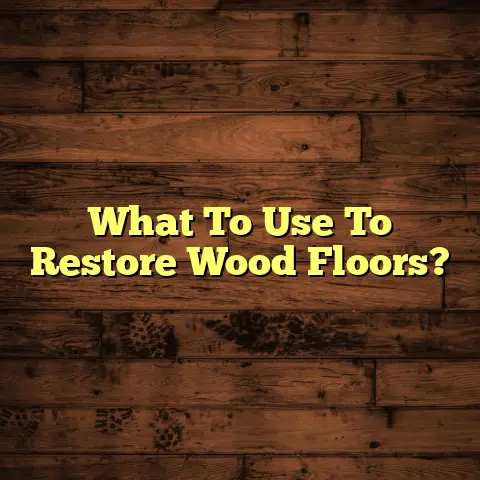Laminate Flooring: Easy Damage? (3 Hidden Weaknesses!)
These days, everyone’s trying to make eco-conscious choices, right?
We want our homes to look great, but we also want to be kind to the planet.
That’s why laminate flooring has become so popular.
It’s a budget-friendly alternative to hardwood that can mimic the look of almost any material.
Plus, it’s easy to install, which is a big win for DIY enthusiasts. But here’s the thing:
While laminate has a lot going for it, it also has some hidden weaknesses that can lead to serious damage down the road.
And trust me, you don’t want to learn about these the hard way (like some of my clients have!).
In this article, I’m going to pull back the curtain and reveal the three biggest vulnerabilities of laminate flooring.
We’ll dive into moisture sensitivity, scratch and dent issues, and its overall longevity compared to other flooring types.
So, if you’re considering laminate for your next project, stick around! This is information you need to know.
Section 1: Overview of Laminate Flooring
Definition and Composition
So, what exactly is laminate flooring?
Think of it as a multi-layered sandwich.
Typically, you’ve got four key layers:
- Wear Layer: This is the top layer,
a clear, protective coating that resists scratches
and stains. It’s usually made of aluminum oxide. - Design Layer: This is where the magic happens!
A high-resolution photograph of wood, stone,
or whatever pattern you desire is printed on this layer. - Core Layer: This is the heart of the laminate,
usually made of high-density fiberboard (HDF)
or medium-density fiberboard (MDF).
This layer provides stability and impact resistance. - Backing Layer: The bottom layer provides
a moisture barrier and helps to balance the board,
preventing warping.
These layers are fused together under high pressure. The result? A durable, attractive, and relatively inexpensive flooring option.
Benefits of Laminate Flooring
Why is laminate so popular? Well, for starters, it’s incredibly cost-effective.
Compared to solid hardwood, tile, or even some types of vinyl, laminate is a much more budget-friendly choice.
Installation is another big draw.
Many laminate products feature click-lock systems, making them a breeze to install yourself.
(Though, I always recommend professional installation for the best results!)
Maintenance is also a snap.
Just sweep or vacuum regularly and mop occasionally with a damp cloth. No need for special polishes or waxes like you would with hardwood.
And let’s not forget the variety.
Laminate comes in a seemingly endless array of colors, patterns, and textures.
You can get the look of exotic hardwood, rustic stone, or even modern concrete without breaking the bank.
Environmental Impact
Now, let’s talk about the “eco” factor.
Laminate can be a surprisingly sustainable choice.
Many manufacturers use recycled wood fibers in the core layer, reducing the demand for virgin timber.
Plus, some laminate products are certified by organizations like FloorScore, which means they meet strict standards for indoor air quality.
This is important because some flooring materials can release harmful volatile organic compounds (VOCs).
Choosing a FloorScore-certified laminate ensures that you’re not bringing those toxins into your home.
For example, according to the North American Laminate Floor Association (NALFA), look for products with the NALFA certification, ensuring they meet stringent performance and environmental standards.
Section 2: Hidden Weakness #1 –
Moisture Sensitivity
Okay, now let’s get to the nitty-gritty.
This is where I start to see problems arise with laminate.
Understanding Moisture Damage
Laminate’s biggest enemy? Water.
While that wear layer offers some protection, the core layer is highly absorbent.
When water seeps into the seams between planks, it can cause the core to swell and warp.
Think of it like a sponge – once it gets wet, it expands and loses its shape.
This swelling can lead to buckling, peaking, and even complete delamination of the flooring.
And it’s not just spills that you need to worry about.
High humidity can also cause problems over time, especially in areas like bathrooms and basements.
Common Sources of Moisture
So, where does all this moisture come from?
Here are some common culprits I see:
- Spills: Obvious, right? But even small spills that
aren’t cleaned up promptly can cause damage. - Leaks: Leaky pipes under sinks,
dishwashers, or refrigerators can wreak havoc
on laminate flooring. - High Humidity: Bathrooms, basements,
and even kitchens can have high humidity levels
that can gradually damage laminate. - Pet Accidents: Let’s face it, accidents happen.
But pet urine is particularly damaging to laminate
because it’s acidic and can penetrate quickly. - Improper Cleaning: Using too much water
when mopping or steam cleaning can force moisture
into the seams.
Long-Term Consequences
Moisture damage isn’t just an aesthetic problem.
It can also lead to some serious long-term consequences:
- Costly Repairs or Replacement: Once laminate
is significantly damaged by moisture,
it often needs to be completely replaced. - Mold and Mildew Growth: Damp environments are
breeding grounds for mold and mildew,
which can trigger allergies and respiratory problems. - Reduced Home Value: Water-damaged flooring
can be a major turnoff for potential buyers
and can significantly reduce your home’s value. - Compromised Indoor Air Quality: Mold growth
can release spores into the air,
contributing to poor indoor air quality.
Real-Life Examples
I’ve seen so many cases of moisture-damaged laminate.
One that sticks out is a client who had laminate installed in their basement.
They didn’t realize that their foundation had a minor leak. Over time, the laminate started to buckle and warp.
By the time they called me, the damage was extensive, and they had to replace the entire floor.
Another client had laminate in their kitchen.
A small leak under their dishwasher went unnoticed for weeks. The laminate around the dishwasher swelled, and mold started to grow.
They ended up having to replace the flooring and deal with mold remediation, which was a huge headache.
These stories are a reminder that even though laminate is affordable and attractive, it’s crucial to be aware of its weaknesses and take steps to protect it from moisture.
According to a report by the Institute of Inspection, Cleaning and Restoration Certification (IICRC), water damage is one of the most common causes of flooring failure, including laminate.
Section 3: Hidden Weakness #2 –
Scratches and Dents
Let’s talk about another common issue I see with laminate: scratches and dents.
Vulnerability to Physical Damage
While that wear layer offers some protection, it’s not invincible.
Laminate is susceptible to scratches and dents, especially in high-traffic areas or homes with pets and kids.
Think about it: You walk across your floor multiple times a day, dragging furniture, dropping objects, and tracking in dirt and debris.
All of these things can contribute to wear and tear on your laminate flooring.
Factors Contributing to Damage
So, what causes these scratches and dents? Here are some common culprits:
- Furniture Movement: Dragging furniture across
laminate flooring is a recipe for disaster.
Always use furniture pads or sliders to protect the surface. - Pet Claws: Pets’ nails can easily scratch laminate,
especially if they’re not regularly trimmed. - Inappropriate Cleaning Tools: Using abrasive
cleaning tools like steel wool or harsh scrub brushes
can damage the wear layer. - High Heels: Those stilettos might look fabulous,
but they can leave dents and scratches on laminate flooring. - Dropped Objects: Dropping heavy or sharp objects
can cause dents and gouges.
Visual Impact
Scratches and dents can really detract from the overall appearance of your flooring.
Even small imperfections can become noticeable over time, especially in areas with lots of natural light.
A scratched or dented floor can make your home look worn and neglected, even if everything else is spotless.
It can also give the impression that the flooring is of lower quality than it actually is.
Preventive Measures and Real-Life Examples
I had a client who installed laminate in their living room.
They loved the look of it, but they had two large dogs who loved to run and play indoors.
Within a few months, the floor was covered in scratches from their claws. They were so disappointed.
I advised them to invest in some good-quality furniture pads and to trim their dogs’ nails regularly.
I also recommended using area rugs in high-traffic areas to provide an extra layer of protection.
Another client had laminate in their dining room.
They hosted a lot of dinner parties and often moved the chairs around.
Unfortunately, they didn’t use furniture pads, and the floor became scratched and dented over time.
They ended up having to replace the flooring sooner than they expected.
These stories highlight the importance of taking preventive measures to protect your laminate flooring from scratches and dents.
According to the American Flooring Association (AFA), regular maintenance and proper care can extend the life of laminate flooring and minimize the appearance of scratches and dents.
Section 4: Hidden Weakness #3 –
Lack of Longevity Compared to
Other Flooring Types
Finally, let’s talk about longevity.
While laminate is a durable material, it doesn’t last as long as some other flooring options.
Comparative Durability
Compared to hardwood, tile, or even some types of vinyl, laminate has a shorter lifespan.
Solid hardwood can last for decades, even centuries, with proper care.
Tile is incredibly durable and can withstand heavy foot traffic and moisture without damage.
Even high-quality vinyl can last for 20 years or more.
Laminate, on the other hand, typically lasts for 10-20 years, depending on the quality of the product and how well it’s maintained.
Factors Affecting Longevity
What contributes to this shorter lifespan?
Here are some key factors:
- Quality of Materials: Cheaper laminate products
often use lower-quality materials that are more
susceptible to damage. - Installation Methods: Improper installation can
shorten the lifespan of laminate flooring.
Gaps between planks or uneven subfloors can
cause the flooring to wear out more quickly. - Maintenance Practices: Neglecting regular
maintenance can also reduce the lifespan of laminate.
Failing to clean up spills promptly or using
inappropriate cleaning products can damage the flooring. - Traffic Levels: High-traffic areas will wear out
laminate flooring more quickly than low-traffic areas.
Cost vs. Longevity
One of the main reasons people choose laminate is because it’s affordable.
But it’s important to consider the long-term costs.
While laminate may be cheaper upfront, you may end up having to replace it sooner than you would with hardwood or tile.
This means you’ll have to spend more money on materials and installation in the long run.
It’s a trade-off between initial cost savings and long-term durability.
Homeowner Testimonials
I had a client who installed laminate in their entire house.
They loved the look of it and were happy with the price.
However, after about 8 years, the laminate in their kitchen and entryway started to show significant wear and tear.
They ended up having to replace those areas, which was a major expense.
They told me they wished they had invested in a more durable flooring option, even if it meant spending more money upfront.
Another client had laminate in their basement.
They didn’t realize that their basement was prone to flooding.
The laminate was repeatedly damaged by water, and they had to replace it every few years.
They eventually switched to tile, which was a more water-resistant option.
These stories illustrate the importance of considering longevity when choosing flooring.
While laminate can be a good option for some situations, it’s not always the best choice for high-traffic areas or areas prone to moisture.
According to a study by Consumer Reports, laminate flooring typically has a lifespan of 10-20 years, while hardwood can last for 50-100 years or more.
Conclusion
So, there you have it – the three hidden weaknesses of laminate flooring: moisture sensitivity, scratch and dent issues, and a shorter lifespan compared to other flooring types.
I hope this article has shed some light on the potential challenges of laminate and helped you make a more informed decision about your flooring options.
Remember, laminate can be a great choice for certain situations, especially if you’re on a budget and looking for an easy-to-install option.
But it’s crucial to be aware of its limitations and take steps to protect it from damage.
Weigh the benefits against the potential risks and challenges, and choose the flooring that’s right for your needs and lifestyle.
And as always, if you have any questions or need help with your flooring project, don’t hesitate to reach out to a professional.
Happy flooring!





